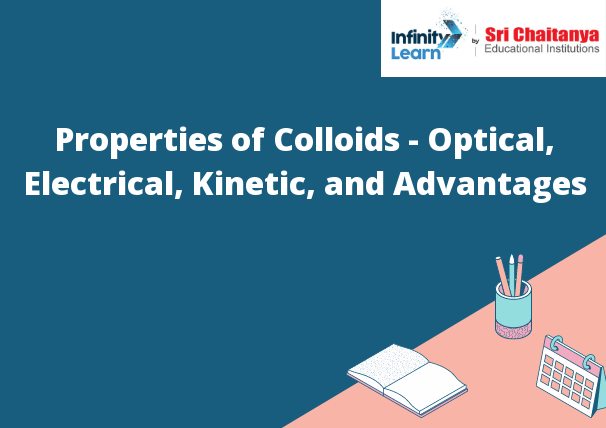Table of Contents
Introduction to Properties of Colloids
A colloid is a substance that consists of small particles of one substance dispersed in another substance. The dispersed particles are typically smaller than 1 micrometer in size. Colloids are classified as either suspensions or emulsions.
Suspensions are colloids in which the dispersed particles are not dissolved in the surrounding liquid. The particles are held in suspension by forces such as electrical attraction, Brownian motion, and surface tension.
Emulsions are colloids in which the dispersed particles are dissolved in the surrounding liquid. The dispersed particles are held in suspension by forces such as electrical attraction, Brownian motion, and surface tension.

Properties of Colloidal Solution
A colloidal solution is a type of mixture in which one substance, the dispersed phase, is dispersed evenly throughout another substance, the dispersion medium. The dispersed phase can be a solid, liquid, or gas, while the dispersion medium is typically a liquid. Colloidal solutions are also known as colloidal dispersions, colloidal suspensions, or simply suspensions.
The most important property of a colloidal solution is its stability. A stable colloidal solution will remain evenly dispersed for a long period of time. If the dispersed phase is a solid, it will remain in suspension and will not settle to the bottom of the dispersion medium. If the dispersed phase is a liquid, it will not form droplets that will eventually merge to form one large droplet. If the dispersed phase is a gas, it will remain in suspension and will not escape from the dispersion medium.
Another important property of colloidal solutions is their viscosity. The viscosity of a colloidal solution is typically much higher than the viscosity of the dispersion medium. This is because the dispersed phase is in a very small size range and is unable to flow easily through the dispersion medium.
The final important property of colloidal solutions is their color. The dispersed phase in a colloidal solution will typically have a different color than the dispersion medium. This is because the dispersed phase is typically very small and is not able to scatter light in the same way as
Optical Properties of Colloids
- The optical properties of colloids are determined by their size, shape, and composition. Colloids can be transparent, translucent, or opaque, depending on their size and composition.
- Transparent colloids allow light to pass through them with little scattering. This makes them look clear or colorless. Examples of transparent colloids include water, alcohol, and oil.
- Translucent colloids allow light to pass through them, but they scatter the light. This makes them look cloudy or milky. Examples of translucent colloids include milk, yogurt, and Jell-O.
- Opaque colloids do not allow light to pass through them. This makes them look solid or black. Examples of opaque colloids include ink, paint, and blood.
Kinetic Properties of Colloids
The kinetic properties of a colloid refers to the way in which the individual particles within the colloid are able to move around. This movement is determined by the size and weight of the particles within the colloid. Larger and heavier particles will move more slowly than smaller and lighter particles. This is because the larger and heavier particles have more mass and are more resistant to being moved by the forces of gravity and inertia.
Electrical Properties of Colloids
- The electrical properties of colloids depend on the size, shape, and composition of the particles. In general, the smaller and more uniform the particles, the more electrical conductivity the colloid will have.
- Some colloids, such as suspensions of iron filings in water, are strongly magnetic. The particles in these colloids are attracted to a magnetic field and line up along the field lines.
Elect osmosis
In electroosmosis, a liquid is forced through a porous material by the application of an electric field. This is the principle behind electrodialysis, a process used to desalinate water.
What are the Main Features of Colloidal Solutions?
The main features of colloidal solutions are that they are solutions of small particles that are dispersed evenly throughout a liquid. The small particles are typically less than 1 micrometer in size, and they are held in suspension by a weak force called Brownian motion. Colloidal solutions are usually transparent, but they can also be cloudy or opaque depending on the size of the particles.
Disadvantages with colloids:
The disadvantages with colloids are that they are not as efficient as other forms of drug delivery, they are more expensive to produce, and they can be more difficult to stabilize.
Advantages of Colloids
There are many advantages to using colloids in various applications. Some of the key benefits include:
- Increased solubility – Colloids can dissolve in water more easily than other substances, which makes them ideal for a variety of applications.
- Increased stability – Colloids are more stable than other substances, meaning they are less likely to separate or dissolve over time.
- Increased dispersibility – Colloids can be dispersed more easily than other substances, meaning they can be easily mixed with other materials.
- Increased compatibility – Colloids are compatible with a variety of other substances, making them ideal for use in a variety of applications.







